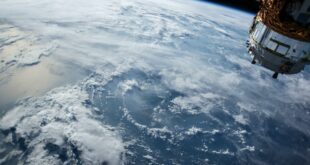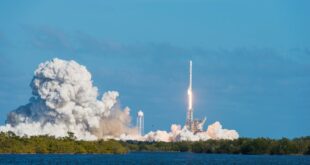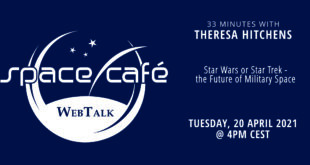by Luisa Low

During this week’s Space Café episode, SpaceWatch.Global publisher Torsten Kriening had the chance to speak with space reporter, Theresa Hitchens.
Navigating
Theresa is a space and air force reporter at Breaking Defense, a digital magazine that reports on the strategy, politics and technology of the international defence sector.
With a career spanning the US capital and Geneva, she worked as a senior researcher at the University of Maryland’s Centre for International and Security Studies, and prior to that was the Director of the United Nations Institute for Disarmament Research.
On top of her impressive CV, Theresa is a “Renaissance” woman with varying expertise and interests. A self proclaimed science fiction buff, she uses Star Wars and Star Trek as inspiration and caution to better understand war and diplomacy in space.
While Star Wars is a cautionary tale of what it is to be in perpetual war – the “Wild West” of space, Start Trek is a lesson in best practice and honourable space protocol. This is what we learnt.
Space war? Keep calm and deactivate your emotion chip
There’s no doubt that within the media and the industry itself that space is back in the limelight, a focus driven by technological innovation and the anniversary of the Moon landing. However, much like bygone Cold War worries, this refocus has also brought on anxiety about the potential outbreak of a space war.
Theresa urges rationality, saying that although space militarisation is worrying, space has actually been militarised since the industry’s inception.
“There is a lot of rhetoric today that is perhaps, at best, a myopic view, and at worse historical revisionism that somehow in the recent space space was a benign environment where no one had to worry about military threats.”
“That’s not true. Space has been been used for military purposes since the dawn of the space age.”
However, she also says there is one key difference in how space is militarised in the modern day compared to the Cold War years.
“It’s useful for military purposes today, in a way that wasn’t during the Cold War, where space was primarily a strategic thing. In the Cold War, sellers were primarily used for intelligence purposes to spy on each other.”
However, the key difference today is space assets are used for activities and planning. She said: “Space assets, such as satellites are being used for day-to-day military operations, such as for planning logistics, targeting weapons, the Global Positioning System, GPS, position, timing and navigation satellites.”
Weapons and space
There are three main categories when it comes to weapons and space, says Theresa, not all of which are in space – an important distinction to understanding how a space war could actually look like.
The first of the weapons categories is “ground to space”, which Theresa says are anti-satellite weapons such as missiles which can be used to blast satellites to “smithereens”. This category has been tested by the United States, China, Russia and, most recently, India.
The second category is “space-to-space” weapons, which refers to any space object that is used deliberately to harm another space object, such as constellations and cube-sats.
Lastly, the third refers to “space-to-ground” weapons – arguably the most dangerous to humankind and Earth, such as former US President Ronald Reagan’s SDI program, or what has been imagined in Star Wars.
These weapons can then fall into the category of reversible or irreversible – the difference being whether they are destructive or disabling, and can include cyber attacks and radio frequency jammers.
A new hope
Theresa believes the world is at a crossroads and we have reached a point in the new-age space race where it’s unclear whether countries will go “full boar” on space militarisation or decide on cohesive regulation.
She also says governments have yet to develop a holistic view on space, where government, social, economic and military uses are balanced.
However, she is also hopeful that the arena will evolve into something more like Star Trek – that regulation, compliance and international cooperation will eventually carry through and competing interests begin to be balanced
“For the first time in my professional career, I am seeing some serious discussion in major spacefaring countries about how we need to constrain military activities in space.”
But what about “rods from god”?
“Rods from god” refers to the idea of putting a mothership in space that carries tungsten rods that would be dropped from orbit, effectively to “reign hell” on Earth. Has modern science rendered it possible or is the next Thor film the only place we’re likely to see such a weapon?
“That type of capability still remains science fiction because the laws of physics haven’t changed in the last 20 years. And the laws of physics makes that pretty untenable.”
It looks like life can’t always imitate art after all.
To listen to Theresa Hitchens’s insights into the space industry, you can watch the full program here:
Space Cafe is broadcast live each Tuesday at 4 pm CEST. To subscribe and get the latest on the space industry from world-leading experts visit – click here.
*Luisa Low is a freelance journalist and media adviser from Sydney, Australia. She currently manages Media and Public Relations for the University of Sydney’s Faculty of Engineering.
 SpaceWatch.Global An independent perspective on space
SpaceWatch.Global An independent perspective on space




